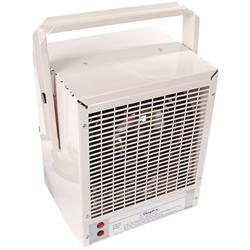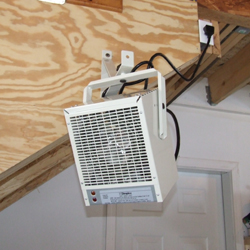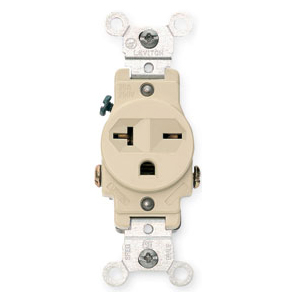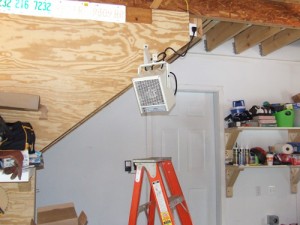Electric Garage | Workshop Heater Review
Dimplex DGWH4031 Garage | Workshop Heater


Dimplex DGWH4031 Features
- Product Dimensions: 9.5″ x 10.5″ x 14.5″
- Product Weight: 18 pounds
- Watts: 4,000
- BTUs: 13,648
- Mounting Bracket Included
- Automatic Temperature Control
- Input: 240 volts, 16.7 amps
Easy Installation


Next the heater is attached to the bracket with a bolt and T-screw. The mounting bracket and support bracket allow you to swivel the heater and also tilt it. This is a nice feature that allows you to easily aim the heat where it’s
Electrical Supply


Overall Impression


There are a few things we think are worth mentioning. First off we don’t recommend you hang the heater too high as it makes it hard to reach the thermostat control on the back of the unit. We recommend you install the heater so you can reach the back of it from the ground without a ladder.
Secondly, in our opinion this unit is best suited for small garages or workshops. The small size of this unit had a difficult time heating up our 28×32 garage on a day that was about 20 degrees outside and 35 degrees in the garage. If you have a normal sized garage then we think you’ll want a unit that’s quite a bit larger.
Overall we think the Dimplex garage heater is a good product. It’s built with quality materials and it’s easy to install. If you’re looking for an electric garage or workshop heater for a small space (under 400 sq. ft.) then this is a good choice.
Where To Buy
If you’d like to buy one of these heaters you can purchase it from Air & Water Inc. at the following link:
Recent Posts
Framing Stick Nailer vs Coil Nailer
Which is Better a Stick Nailer or Coil Nailer? Framers have many choices in nailers…
How Many Roofing Nails Per Square of Shingles
Estimating How Many Nails for a New Roof When it comes to estimating materials for…
Composite / PVC Decking – Layout Tips & Advice
Composite / PVC Decking Layout Tips and Advice Composite and PVC decking have really changed…
Benefits of an ERV System (Energy Recovery Ventilator)
Benefits of ERV Systems (Energy Recovery Ventilator) If you're building a new home or doing…
Vermiculite Attic Insulation Abatement
Vermiculite Attic Insulation If your home was built before 1990 there is a chance it…
Nuisance Tripping of AFCI (Arc Fault) Circuit Breakers
Arc Fault (AFCI) Circuit Breakers Tripping Often An arc-fault circuit interrupter (AFCI) or arc-fault detection…

View Comments
I have a similar heater that I use all the time. I have a 30A unit for an insulated 500 ft space and makes it comfortable to work in a sweatshirt without the fumes from kerosene-fueled units. This unit is definitely undersized for a 28 x 32 shop. If you live in a cold climate, you may need to run this size heater for an hour or two to get your shop reasonably toasty, but you will find the clean, fume-free, heat most enjoyable to work in.
Also having the ability to take this type of heater off the ceiling for a preseason cleaning/blow out with compressed air is a good idea. Seemingly, all heaters of this type tend to collect a bit of surface rust and if you don’t shake/blow off the heater element upon your initial seasonal start up you are treated to a brownish red dust storm... Yuck!